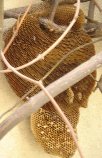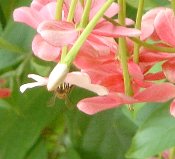-Dr..Susan Sharma
There are alarm bells ringing in different parts of the world about the disappearance of wild bees. In India we still have them, and it is important to realize their contribution to our food security. For many urbanites honey bees are associated with
the painful sting and hence, are insects to keep away and be kept away as far as possible. That they should be kept away from gardens and parks is an attitude we must change.
Quote:
Bees as Pollinators
The unique relationship between pollinators and flowering plants has been evolving for over 100 million years and there are currently estimated to be around 200,000 different species of animal worldwide acting as pollinators. These include beetles, bats,
flies, wasps, birds, butterflies, moths and some mammals; but it is without doubt the humble bee that does the lion’s share of the work.
From a ‘human-centric’ point of view, bees are responsible for pollinating around a third of the food we eat (this includes meat from animals that graze on bee-pollinated clover and alfalfa) – as well as many of the crops we grow for drinks, medicines
and textiles. However, bees are important for more reasons than the fact that they pollinate food for human consumption…
Bees also pollinate over 80% of the world’s wild flowers and, interestingly, whilst great attention is always given to the bee’s role as our main crop pollinator, we would do well to note that they play an equally important role as ‘keystone species’ in
the planet’s eco-systems.
-Unquote

The above beehive was formed on the Glory Bower Creeper. Beehives can be found on Anaar trees, Silk Cotton trees etc. too.
Bees can be an integral part of any garden or Park. They do not attack unless their beehive is disturbed.

The above photo is the beehive when it has outlived its utility.
Observing how and when bees collect honey from flowers in the garden is revealing. Bees seem to keep time based on the rays of sunbeam falling on the beehive and on the flowers from where they collect honey and in the process help pollinate.

Bees love the yellow flowers of the methi plant

The Madhu Malti flowers are a treat for the honey bees too.